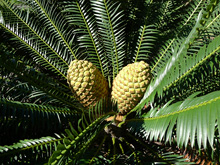 Palm-like cycads have been around since the last dinosaurs munched on them 65.5 million years ago, but those that we see today are really only a few million years old, according to a new study by an international team of scientists.
Palm-like cycads have been around since the last dinosaurs munched on them 65.5 million years ago, but those that we see today are really only a few million years old, according to a new study by an international team of scientists.
“Cycads are poster-child living fossils, yet the living species are really young,” reports UCMP Director and Professor of Integrative Biology Charles Marshall, co-author of the study appearing online October 20 (in advance of publication) in Science. “So, while the group as a whole are living fossils, the species themselves are not.”
Cycads are endangered cone-bearing plants that have survived in tropical and subtropical pockets to the present. The UC Botanical Garden hosts a nationally recognized collection of cycads, many of which were rescued from plant smugglers.
Molecular evidence was used to show that the surviving cycad species are actually not relics of the dinosaur era, but the result of an evolutionary explosion among cycads that began about 12 million years ago.
“All the cycad species we examined diverged from their nearest relatives in a really narrow window of geologic time, well after the dinosaurs became extinct” said co-author Charles Marshall, director of the University of California Museum of Paleontology and a UC Berkeley professor of integrative biology. “This was a global event, and then the diversification essentially stopped in the last couple of million years. There is no other group of plants that has this remarkable pattern of diversification.”

“We can now say that living cycad species are not ancient or leftovers from dinosaur times,” said Nathalie Nagalingum, a research scientist at the Royal Botanic Garden in Sydney, Australia, who led the study while a post-doctoral fellow in Marshall’s laboratory at Harvard University and subsequently UC Berkeley. “They evolved independently of dinosaurs only 12 million years ago. The recent radiation of cycads radically changes our view of these emblematic living fossils.”
Nagalingum, Marshall and colleagues studied all 11 groups of cycad and two-thirds of the world’s 300 species, developing a molecular clock that told them how recently living cycads diverged from one another. If they had truly dated from the dinosaur era, the times of divergence between the living species would have dated back to their heyday in the Jurassic, which began 200 million years ago. Instead, they found the living species originated within the last 12 million years or so.
“It was amazing that all the cycad groups across the globe in Australia, Africa, Southeast Asia and Central America began to diversify at the same time,” Nagalingum said. “This indicated that a global trigger may have been responsible. It seems that the trigger was a change in the climate, that is, when global cooling began and when the world started having more distinct seasons. Cycads are very slow-growing plants so it’s hard to predict whether cycads can survive, now that climate change is occurring at a much faster rate,” she said.
Nagalingum and Marshall’s coauthors include Tiago Quental, a former UC Berkeley post-doc now at the Universidade Estadual de São Paulo, Brazil; Hardeep Rai of Utah State University; Damon Little of the New York Botanical Garden; and Sarah Mathews of Harvard University’s Arnold Arboretum.
See the abstract of the study, Recent Synchronous Radiaton of a Living Fossil on the Science website.